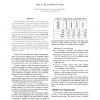Free Online Productivity Tools
i2Speak
i2Symbol
i2OCR
iTex2Img
iWeb2Print
iWeb2Shot
i2Type
iPdf2Split
iPdf2Merge
i2Bopomofo
i2Arabic
i2Style
i2Image
i2PDF
iLatex2Rtf
Sci2ools
115
Voted
HPCA
2008
IEEE
2008
IEEE
Amdahl's Law in the multicore era
We apply Amdahl's Law to multicore chips using symmetric cores, asymmetric cores, and dynamic techniques that allows cores to work together on sequential execution. To Amdahl's simple software model, we add a simple hardware model based on fixed chip resources. A key result we find is that, even as we enter the multicore era, researchers should still seek methods of speeding sequential execution. Moreover, methods that appear locally inefficient (e.g., tripling sequential performance with a 9x resource cost) can still be globally efficient as they reduce the sequential phase when the rest of the chip's resources are idle. To reviewers: This paper's accessible form is between a research contribution and a perspective. It seeks to stimulate discussion, controversy, and future work. In addition, it seeks to temper the current pendulum swing from the past's underemphasis on parallel research to a future with too little sequential research. Today we are at an infle...
Related Content
| Added | 01 Dec 2009 |
| Updated | 01 Dec 2009 |
| Type | Conference |
| Year | 2008 |
| Where | HPCA |
| Authors | Mark D. Hill |
Comments (0)

